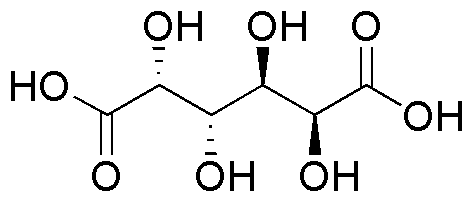Mucic acid is widely utilized in research focused on:
- Pharmaceutical Development: Mucic acid serves as a precursor in the synthesis of various pharmaceutical compounds, enhancing drug formulation processes.
- Food Industry: It is used as a food additive for its stabilizing properties, improving the texture and shelf-life of certain products.
- Biochemical Research: Researchers utilize mucic acid in studies related to carbohydrate metabolism, providing insights into metabolic pathways and enzyme functions.
- Cosmetics: Its moisturizing properties make it a valuable ingredient in skincare products, helping to improve skin hydration and texture.
- Biodegradable Plastics: Mucic acid is explored as a component in the production of biodegradable materials, contributing to environmentally friendly packaging solutions.
General Information
Properties
Safety and Regulations
Applications
Mucic acid is widely utilized in research focused on:
- Pharmaceutical Development: Mucic acid serves as a precursor in the synthesis of various pharmaceutical compounds, enhancing drug formulation processes.
- Food Industry: It is used as a food additive for its stabilizing properties, improving the texture and shelf-life of certain products.
- Biochemical Research: Researchers utilize mucic acid in studies related to carbohydrate metabolism, providing insights into metabolic pathways and enzyme functions.
- Cosmetics: Its moisturizing properties make it a valuable ingredient in skincare products, helping to improve skin hydration and texture.
- Biodegradable Plastics: Mucic acid is explored as a component in the production of biodegradable materials, contributing to environmentally friendly packaging solutions.
Documents
Safety Data Sheets (SDS)
The SDS provides comprehensive safety information on handling, storage, and disposal of the product.
Product Specification (PS)
The PS provides a comprehensive breakdown of the product’s properties, including chemical composition, physical state, purity, and storage requirements. It also details acceptable quality ranges and the product's intended applications.
Certificates of Analysis (COA)
Search for Certificates of Analysis (COA) by entering the products Lot Number. Lot and Batch Numbers can be found on a product’s label following the words ‘Lot’ or ‘Batch’.
*Catalog Number
*Lot Number
Certificates Of Origin (COO)
This COO confirms the country where the product was manufactured, and also details the materials and components used in it and whether it is derived from natural, synthetic, or other specific sources. This certificate may be required for customs, trade, and regulatory compliance.
*Catalog Number
*Lot Number
Safety Data Sheets (SDS)
The SDS provides comprehensive safety information on handling, storage, and disposal of the product.
DownloadProduct Specification (PS)
The PS provides a comprehensive breakdown of the product’s properties, including chemical composition, physical state, purity, and storage requirements. It also details acceptable quality ranges and the product's intended applications.
DownloadCertificates of Analysis (COA)
Search for Certificates of Analysis (COA) by entering the products Lot Number. Lot and Batch Numbers can be found on a product’s label following the words ‘Lot’ or ‘Batch’.
*Catalog Number
*Lot Number
Certificates Of Origin (COO)
This COO confirms the country where the product was manufactured, and also details the materials and components used in it and whether it is derived from natural, synthetic, or other specific sources. This certificate may be required for customs, trade, and regulatory compliance.

